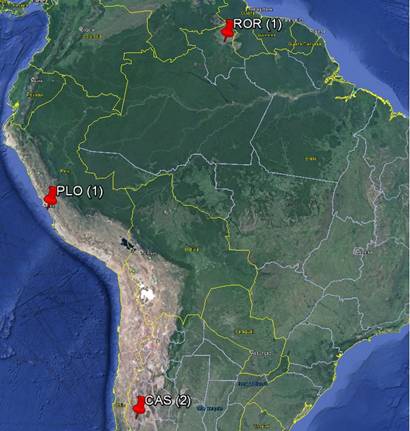Atmospheric Electric Field Network in South America (AFINSA)
PI: Jean-Pierre Raulin (Universidade Presbiteriana Mackenzie) Brazil
The Atmospheric Electric Field (AEF) persists in fair weather regions, without local electrification processes and shows a daily variation with Universal Time independent of where the AEF was measured. This curve is generally known as the Carnegie Curve (Harrison, 2013) and is closely related to the current flowing in the Global Atmospheric Electric Circuit (GAEC).
The GAEC is formed between the Earth’s surface and the ionosphere. The atmosphere of the Earth is located between these two conducting layers. Electrical generators do exist below or inside electrified clouds to maintain the AEF, implying that an electrical current flows up to the ionosphere above these clouds. The electrical circuit is closed by downward currents flowing through the fair weather and semi-fair weather regions of the Earth’s atmosphere and through the rocks and oceans of the Earth´s surface (Rycroft et al., 2008).
The well-known and close correlation between the electrical generating system of the GAEC and the Carnegie curve has been extensively reported. However, the exact link is not well understood and continuous monitoring of the AEF is required in different geographical areas to help in the interpretation of the behavior of the GAEC. Solar and space weather phenomena affect the ionosphere causing disturbances in the GAEC, which can be monitored by analyzing the variations of the fair weather AEF. Transient variations of the intensity of the AEF have also been systematically reported in association with time fluctuations of the secondary cosmic ray flux measured at the same location (Raulin et al., 2014). The GAEC is also used to look for short-term precursors of seismic activity (Tacza et al., 2014). The purpose of the new Atmospheric Electric Field Network in South America (AFINSA) is to improve our understanding of these above questions.
Objectives:
- The main objective is to obtain a daily variation curve of the fair weather AEF (standard curve) based on means on different time scales, such as monthly, seasonal and annual.
- To characterize deviations from the standard curves in relation to the occurrence of external phenomena such as solar events ( flares, proton events) , geomagnetic storms , solar eclipse and seismic activity.
- Characterization and interpretation of the variations of the AEF along with increases in cosmic ray count , in order to understand if the former could be effective in accelerating secondary cosmic particles .
- To infer a possible causal relation between monthly means of daily variation of the fair weather AEF and monthly averages of the occurrence of lightning.
Instrumentation:

Continuous measurements of the atmospheric electric field are recorded at various locations in South America. The already existing locations CAS (2 sensors named CAS1 and CAS2 at El Leoncito, San Juan, Argentina), PLO (1 sensor Punta Lobos, Lima, Peru) and ROR (1 sensor Roraima, Brazil) are shown in the figure at left. New stations are planned for beginning of operation in 2016.
Each sensor consists of a commercially manufactured (Boltek Corporation EFM100-1000120-050205) electric field mill (EFM). The minimum overall sensitivity range is ±20 kV/m and can be improved up to 40 kV/m. The response time of each sensor is 0.1 s. The basic principle of operation of the EFM stands on the fundamental laws of electromagnetism. When a conducting plate is exposed to an electric field , a charge is induced proportional to the electric field intensity and the area of the plate. The EFM produces alternate electrical fields by using an array of electrodes and rotor driven by motor.
The network is operated by CRAAM (Brazil) in collaboration with other institutions: CASLEO (Argentina), ICATE (Argentina), CONIDA (Peru). One of our first task will be to provide AFINSA data access in the form of monthly means of the fair weather AEF. Data are also available upon request to José Tacza Anaya <josect1986[at]gmail.com>.
Financial Support:
Most of the AFINSA project is funded by the Brazilian agencies Conselho Nacional de Desenvolvimento Científico e Tecnológico (CNPq) and MACKPESQUISA.
References:
Harrison,R.G. The Carnegie Curve. Surveys in Geophysics, 34, 2, 209-232. DOI:10.1007/s10712-012-9210-2, 2013.
Raulin, J.-P., Tacza, J., Macotela, E., Fernandez, G. A new South America electric field monitor network. Sun and Geosphere, 9, 111-114, 2014.
Rycroft, M. J., Harrison, R. G., Nicoll, K. A. and Mareev, E. A. An overview of Earth's global electric circuit and atmospheric conductivity. Space Science Reviews, 137 (1-4). 83-105. ISSN 0038-6308 DOI:10.1007/s11214-008-9368-6, 2008.
Tacza, J.C., Raulin, J.-P., Macotela, E.L., Norabuena, E., Fernandez, G., Correia, E., Rycroft, M.J., Harrison, R.G. A new South American network to study the atmospheric electric field and its variations related to geophysical phenomena. J. Atmos. Sol. Terr. Phys. 120, 70–79, 2014.
AFINSA home page